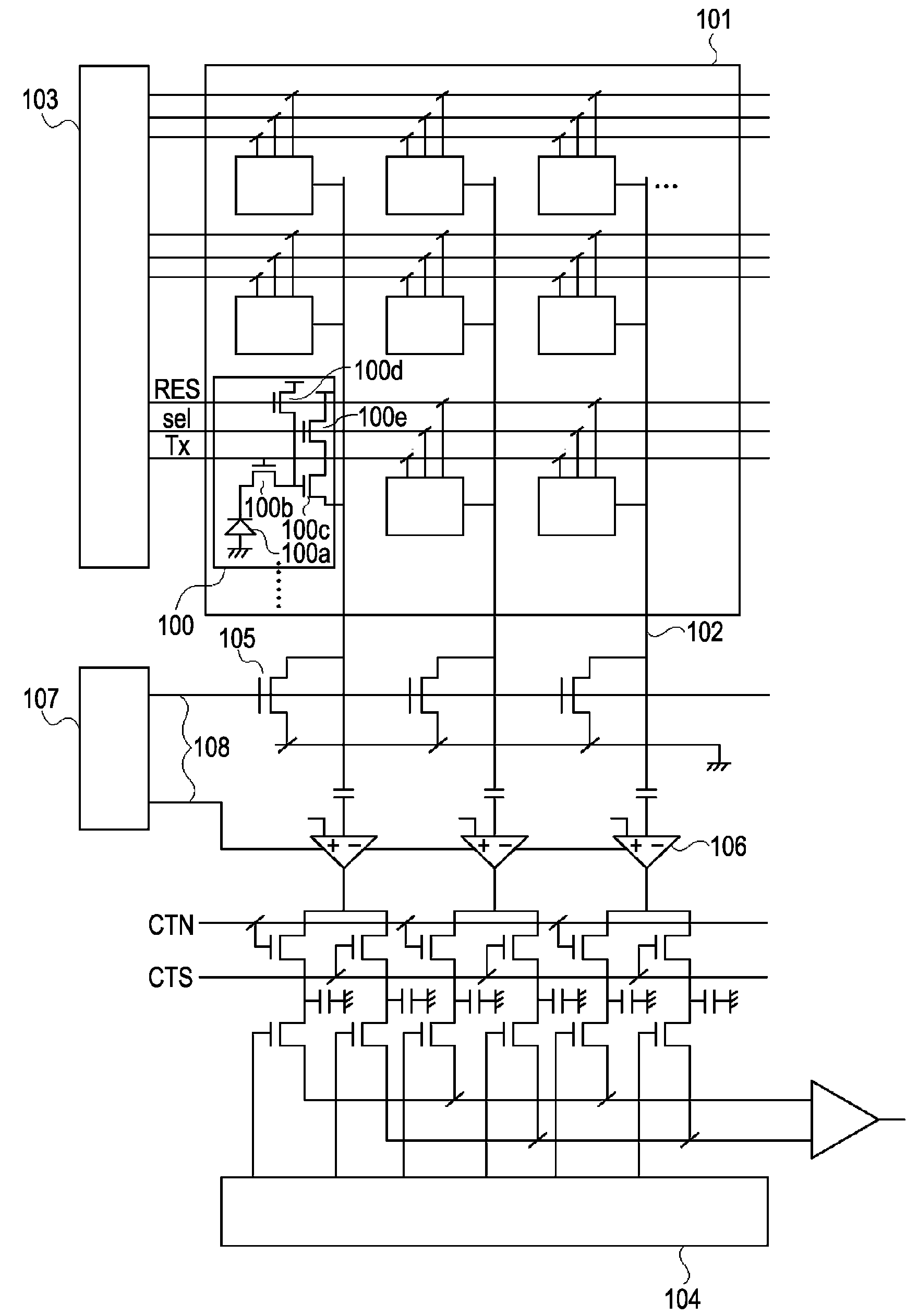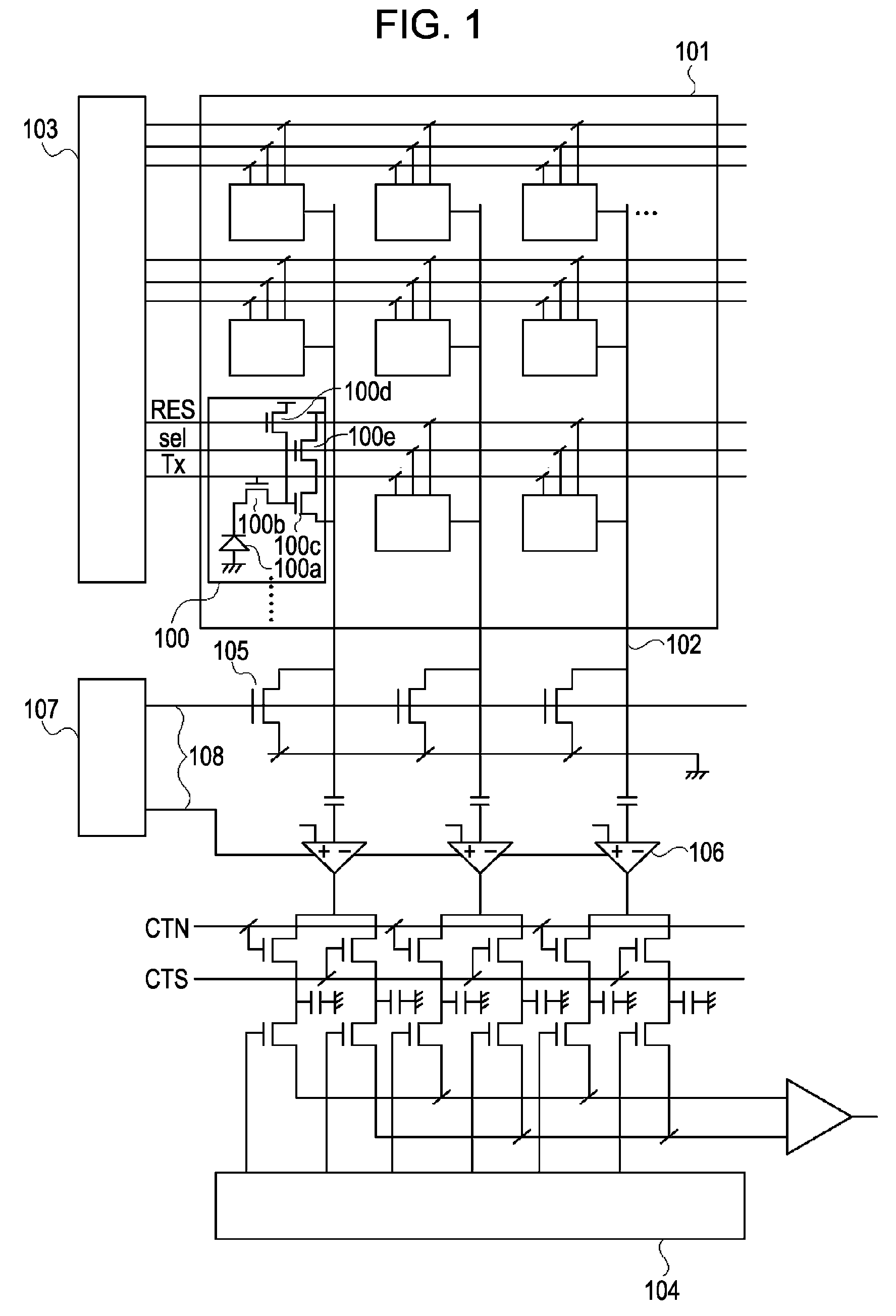Solid-state image pickup device
- Summary
- Abstract
- Description
- Claims
- Application Information
AI Technical Summary
Benefits of technology
Problems solved by technology
Method used
Image
Examples
first embodiment
[0034]FIG. 1 is a conceptual diagram of a solid-state image pickup device according to a first embodiment.
[0035]The solid-state image pickup device includes pixels 100. The pixels 100 each include a photoelectric converter 100a, which is a photodiode in the first embodiment.
[0036]A transfer portion 100b transfers a charge of the photoelectric converter 100a to an input part of a pixel amplifier 100c. The pixel amplifier 100c amplifies and outputs a signal generated in accordance with the charge produced at the photoelectric converter 100a. A reset portion 100d resets the potential of the input part of the pixel amplifier 100c. A select portion 100e controls which signal is to be output to a corresponding one of vertical output lines 102. The foregoing elements can be configured as MOS transistors. The transistor serving as the pixel amplifier 100c is configured as a source follower circuit in combination with a load MOS transistor 105, which will be described separately below.
[0037]...
second embodiment
[0059]FIG. 4 is an equivalent circuit diagram of a voltage supply circuit according to a second embodiment. Elements similar to those of the first embodiment are denoted by the same reference numerals, and detailed descriptions thereof are omitted. In addition to the elements provided in the first embodiment, the voltage supply circuit of the second embodiment includes an operational amplifier circuit (a second amplifier circuit). Referring to FIG. 4, the voltage supply circuit includes an operational amplifier circuit 401 and a feedback path 402. A non-inverting input terminal of the operational amplifier circuit 401 and the voltage supply wire 108 (the output part of the voltage supply circuit) are connected to each other. The operational amplifier circuit 401 is provided between the voltage generator 201 and the sampling switch 202. The feedback path 402 connects an output node of the first amplifier circuit (the transistor 204 and the resistor 205) and an input node of the opera...
third embodiment
[0063]FIG. 5 is an equivalent circuit diagram of a voltage supply circuit according to a third embodiment. Elements similar to those in the first and second embodiments are denoted by the same reference numerals, and detailed descriptions thereof are omitted.
[0064]The third embodiment differs from the second embodiment in that the voltage supply circuit includes a first resistor 501 and a second resistor 502 connected in series on the output side of the transistor 204, with a connection node 503 between the resistors 501 and 502 being connected to the voltage supply wire 108. Operations of the switches and the like are the same as in the first and second embodiments. Also in the third embodiment, noises from the voltage generator 201 and the operational amplifier circuit 401 can be reduced by making the sampling switch 202 nonconductive during CDS processing. Further, in the third embodiment, the 1 / f noise generated in the transistor 204 appears at the output part of the voltage sup...
PUM
 Login to View More
Login to View More Abstract
Description
Claims
Application Information
 Login to View More
Login to View More - R&D
- Intellectual Property
- Life Sciences
- Materials
- Tech Scout
- Unparalleled Data Quality
- Higher Quality Content
- 60% Fewer Hallucinations
Browse by: Latest US Patents, China's latest patents, Technical Efficacy Thesaurus, Application Domain, Technology Topic, Popular Technical Reports.
© 2025 PatSnap. All rights reserved.Legal|Privacy policy|Modern Slavery Act Transparency Statement|Sitemap|About US| Contact US: help@patsnap.com



